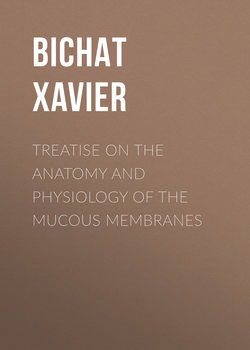Читать книгу Treatise on the Anatomy and Physiology of the Mucous Membranes - Bichat Xavier - Страница 4
SECTION III.
OF THE INTERIOR ORGANIZATION OF MUCOUS MEMBRANES
Оглавление19. Between the mucous and other membranes, as respects their interior organization, there is this essential difference, that they are always formed by several thin fibrous layers; these layers or coats are, with the exception of the rete mucosum, the same as those which compose the skin with which these membranes have the most exact analogy. We are about to examine separately each of these layers, which are the epidermis, the corps papillaire, and the chorion, in their general attributes; we shall afterwards consider the particular modifications which they undergo in the different parts of the mucous surfaces.
20. All authors have admitted the epidermis of mucous membranes: it appears, even, that the greatest part of them have believed that it is merely that portion of the skin which descends into the cavities to line them; Haller in particular is of this opinion; but the least inspection is sufficient to show, that here, as in the skin, it forms but a layer superficial to the corps papillaire and chorion; boiling water, which detaches it from the surface of the palate, the tongue, and even from the pharynx, leaves the two other coats denuded and apparent.
21. This epidermis is very distinct upon the glans, at the anus, at the orifice of the urethra, at the entrances of the nasal fossæ, and of the mouth, and in general wherever the mucous membranes arise from the skin. It is demonstrated in these different places by the frequent excoriations which occur on them; it may be raised from the lips by a very fine lancet by the action of boiling water, a hot iron, or even by epispastics, as the method of the ancients proves, who employed them to produce a fresh raw surface for the cure of the hare lip.
22. But in proportion as we go into the depth of the mucous membranes, the existence of this coat becomes more difficult to be demonstrated; it cannot be raised by the finest instrument, nor detached by boiling water, at least in the gall bladder, in the stomach, and intestines. I have made these experiments in fresh slain animals, and also in those where the natural heat had quite left them. But what our experiments cannot effect, inflammations will often produce. All the authors, who have written on the affections of the organs which are lined by these membranes, mention instances in which flakes, more or less considerable, have been voided by the urethra, anus, mouth, nostrils, &c. Haller has collected a great number of similar observations. Without doubt the separation of the epidermis in these cases is produced nearly in the same way as we observe it in cutaneous inflammations. In many subjects that have died with symptoms of inflammation of the mucous membranes, and which I have already had the opportunity of dissecting, or of seeing dissected, I have not yet been able to observe this separation going on; that is to say, the epidermis separated at one point, and still remaining adherent at others, as in erysipelas. I have tried in vain to produce this effect by the application of an epispastic to the inner surface of the intestines of a dog.
23. This epidermis is subject, like that of the skin, to become callous by pressure. Choppart cites a case of a shepherd, "dont le canal de l'urètre présentoit cette disposition, à la suite de l'introduction fréquemment répétée d'une petite baguette pour se procurer des jouissances voluptueuses." We know the density that this envelope takes in the stomachs of the gallinacea. In certain circumstances, where the mucous membranes are protruded from the body, as in prolapsus ani, inversion of the vagina, in the artificial anus, &c., sometimes the pressure of the dress produces in this epidermis a thickness evidently more considerable than is natural to it.
